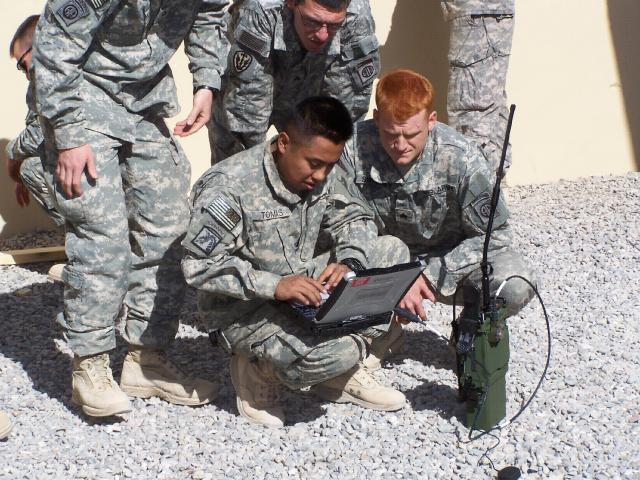Afghanistan: They call it “Tiger University” – a set of classrooms in Kandahar where Soldiers can take a radio crash course before returning to their posts.
In groups of no more than 16, they receive training on the AN/PRC-117G, a wireless multimedia radio allowing troops to exchange large chunks of tactical data, such as video and biometrics.
“It’s got some new capabilities that Soldiers are unaware of, or not quite sure how to leverage to better use the radio,” said Zaphir Shamma, who leads the 117G training in Afghanistan’s Regional Command South. “It’s our job to educate them on the new bells and whistles.”
When the Army sends sophisticated equipment to the battlefield on an accelerated schedule to meet urgent operational needs, troops and their trainers often improvise with solutions like “Tiger U.” The “university” was set up by the 86th Expeditionary Signal Battalion, or ESB, and teaches classes on the 117G and other cutting-edge tactical communications technology.
Soldiers also receive over-the-shoulder training in their vehicles when Shamma’s team, from the Army’s Project Manager Force XXI Battle Command Brigade and Below, or FBCB2, travels to forward operating bases to install the radios.
The FBCB2 team is nearing completion of fielding approximately 2,000 AN/PRC-117G radios to Afghanistan in response to multiple Operational Needs Statements, known as ONS, all of which document where the 117G’s capabilities fill current mission capability gaps.
With a new ONS in place, they will soon start another round of equipping and training – although this time there will be training opportunities for Soldiers prior to deployment, so “when they come into theater, they are already trained on the radio and its capabilities,” Shamma said.
The AN/PRC-117G is serving as an interim networking radio, providing a bridge to next-generation Joint Tactical Radio System, or JTRS radios, said A.J. Parlow, product director for Tactical Radio Communications Systems, which is assigned to PM FBCB2.
“Generally the feedback has been very positive – that these radios are filling a niche they haven’t had before, and making their missions easier,” Parlow said. “This radio is doing its job and it’s adding to the capability of the Soldier.”
For voice communications, the 117G is compatible with the Advanced System Improvement Program, knows as the ASIP, radio, which is the current edition of the broadly fielded Single Channel Ground and Airborne Radio System, or SINCGARS, family of radios. SINCGARS forms the network backbone for fire support, enabling data exchange by units such as field artillery, who need to push digital firing information in order to accurately engage their targets.
“Those (ASIP) radios are essentially half the size of the previous generations, and half the weight” at roughly eight pounds, said James Bowden, the Army’s technical lead for SINCGARS. “And they perform significantly better, with a lot more data capability.”
ASIPs make up approximately 430,000 of the 581,000 radios in the SINCGARS fleet, Bowden said. SINCGARS is the primary voice control radio system for Soldiers at battalion level and below, available for ground (manpack), airborne and vehicular use.
Using the ANW2 waveform, the PRC-117G radio is also helping units expand classified Secret Internet Protocol Router, or SIPR, networks that were previously restricted to fixed sites, said Johnny Boker, a civilian support contractor for PD TRCS.
“The radios have been used to extend radio networks in Kandahar as well as Camp Phoenix, Afghanistan,” Boker said.
Digital tags provide precise tracking of bulk shipments of radios and other 117G equipment from the United States through Kuwait. Once the gear is fielded to a unit’s forward location, it is then formally listed as Theater Provided Equipment and tracked on the unit’s books. That way, brigades can redistribute the radios as necessary among their subordinate battalions.
“It gives asset visibility,” said Shamma, a civilian contractor who deployed to Afghanistan in October 2010. “They can see exactly how many 117Gs are in theater, where they are and what units are in possession of them, in case some assets need to be laterally transferred to units that don’t have that capability.”
Other theater-provided radios include the AN/PRC-148 and AN/PRC-152, handheld radios that are used for intra-squad communications. Carried by foot Soldiers and mounted on tactical platforms such as mine-resistant, ambush-protected vehicles, those radios also provide voice network compatibility with SINCGARS, Bowden said.
When JTRS radios are fielded, they will also use the SINCGARS waveform as well as JTRS waveforms.
“That gives (JTRS) interoperability with the legacy systems,” Bowden said.
SINCGARS and another current force program of record, the Enhanced Position Location Reporting System, or EPLRS, are expected to be in use for the next 20 to 30 years. EPLRS is a digital network radio system that provides the backbone for the terrestrial version of FBCB2, which allows Soldiers in tactical vehicles to track one another’s whereabouts over a computerized topographical map so they can synchronize operations and avoid fratricide.
The satellite version, FBCB2/Blue Force Tracking, is utilized for beyond-line-of-sight communications in mountainous regions.
Whether they are a longstanding program record or a fresh capability in response to an ONS, the radios fielded by PM FBCB2 will continue to be fully supported in the field.
“Whatever kind of training the unit wants and can sustain, we make available to the unit,” Shamma said. “Then we leave it up to the unit to decide how they want to use the radio to better meet their mission requirements.”










